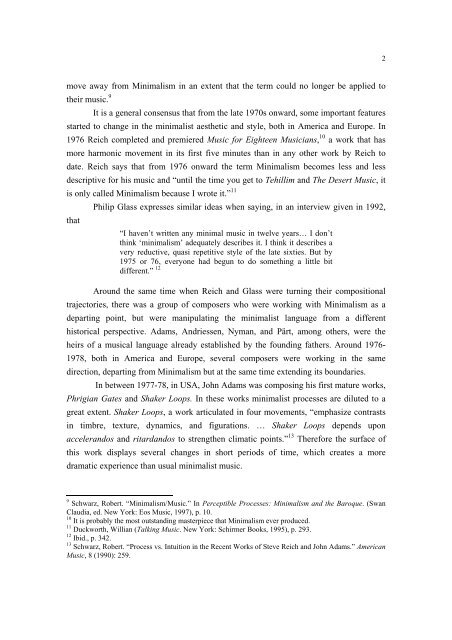Minimalism and Post Minimalism - Dimitri Cervo
Minimalism and Post Minimalism - Dimitri Cervo
Minimalism and Post Minimalism - Dimitri Cervo
You also want an ePaper? Increase the reach of your titles
YUMPU automatically turns print PDFs into web optimized ePapers that Google loves.
move away from <strong>Minimalism</strong> in an extent that the term could no longer be applied to<br />
their music. 9<br />
It is a general consensus that from the late 1970s onward, some important features<br />
started to change in the minimalist aesthetic <strong>and</strong> style, both in America <strong>and</strong> Europe. In<br />
1976 Reich completed <strong>and</strong> premiered Music for Eighteen Musicians, 10 a work that has<br />
more harmonic movement in its first five minutes than in any other work by Reich to<br />
date. Reich says that from 1976 onward the term <strong>Minimalism</strong> becomes less <strong>and</strong> less<br />
descriptive for his music <strong>and</strong> “until the time you get to Tehillim <strong>and</strong> The Desert Music, it<br />
is only called <strong>Minimalism</strong> because I wrote it.” 11<br />
that<br />
Philip Glass expresses similar ideas when saying, in an interview given in 1992,<br />
“I haven’t written any minimal music in twelve years… I don’t<br />
think ‘minimalism’ adequately describes it. I think it describes a<br />
very reductive, quasi repetitive style of the late sixties. But by<br />
1975 or 76, everyone had begun to do something a little bit<br />
different.” 12<br />
Around the same time when Reich <strong>and</strong> Glass were turning their compositional<br />
trajectories, there was a group of composers who were working with <strong>Minimalism</strong> as a<br />
departing point, but were manipulating the minimalist language from a different<br />
historical perspective. Adams, Andriessen, Nyman, <strong>and</strong> Pärt, among others, were the<br />
heirs of a musical language already established by the founding fathers. Around 1976-<br />
1978, both in America <strong>and</strong> Europe, several composers were working in the same<br />
direction, departing from <strong>Minimalism</strong> but at the same time extending its boundaries.<br />
In between 1977-78, in USA, John Adams was composing his first mature works,<br />
Phrigian Gates <strong>and</strong> Shaker Loops. In these works minimalist processes are diluted to a<br />
great extent. Shaker Loops, a work articulated in four movements, “emphasize contrasts<br />
in timbre, texture, dynamics, <strong>and</strong> figurations. … Shaker Loops depends upon<br />
acceler<strong>and</strong>os <strong>and</strong> ritard<strong>and</strong>os to strengthen climatic points.” 13 Therefore the surface of<br />
this work displays several changes in short periods of time, which creates a more<br />
dramatic experience than usual minimalist music.<br />
9<br />
Schwarz, Robert. “<strong>Minimalism</strong>/Music.” In Perceptible Processes: <strong>Minimalism</strong> <strong>and</strong> the Baroque. (Swan<br />
Claudia, ed. New York: Eos Music, 1997), p. 10.<br />
10<br />
It is probably the most outst<strong>and</strong>ing masterpiece that <strong>Minimalism</strong> ever produced.<br />
11<br />
Duckworth, Willian (Talking Music. New York: Schirmer Books, 1995), p. 293.<br />
12<br />
Ibid., p. 342.<br />
13<br />
Schwarz, Robert. “Process vs. Intuition in the Recent Works of Steve Reich <strong>and</strong> John Adams.” American<br />
Music, 8 (1990): 259.<br />
2


